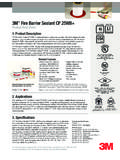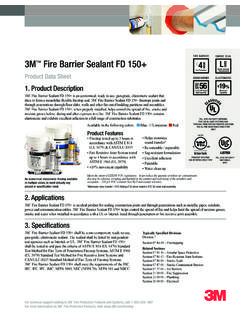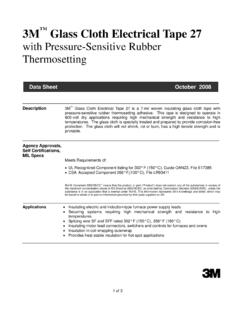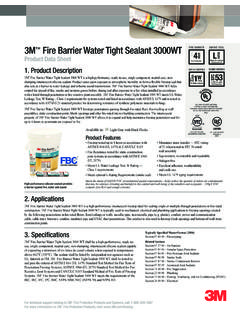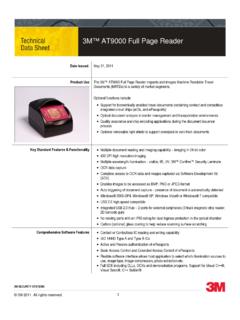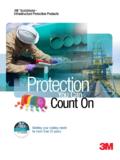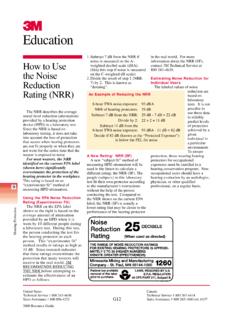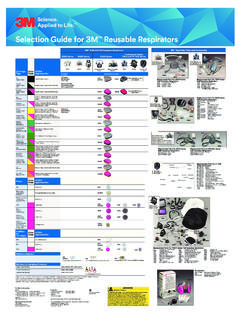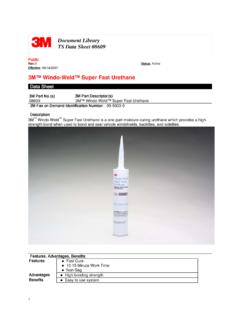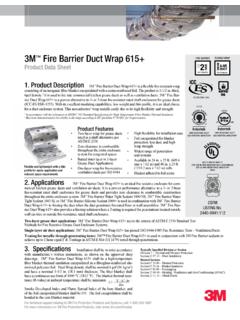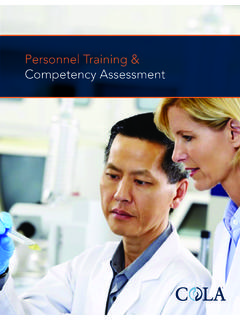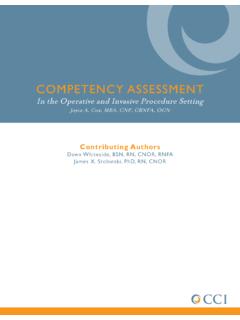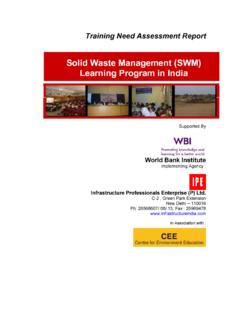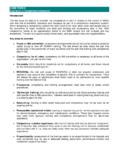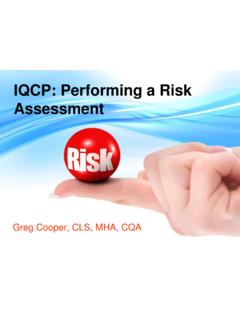Transcription of Hygiene Management Guide
1 3M Clean-Trace Hygiene Management Systemfor Environmental Surfaces Hygiene Management GuideAim 3 Introduction 3 ATP bioluminescent monitoring technology 4 What is Adenosine Triphosphate? 4 The principle of the bioluminescent reaction 4 Data analysis and reporting 43M Recommended Monitoring plan 5 3M Tier 1 plan Education and competency 5 3M Tier 2A plan Routine Monitoring of the Effectiveness of Terminal Cleaning 7 3M Tier 2B plan Monitoring High Risk Areas and Equipment 8 Implementation of an ATP Hygiene Monitoring Program 10 Identification of test points and sample plans 10 Pass/Fail Threshold Recommendation 11 Determination of testing frequency 12 Collection of Data 13 Establish metrics for each tier implemented 14 Establishment of corrective action procedures 15 Continuous improvement steps 16 Appendix 1 Test Point Selection and Recommended Sample Plans 16 References 19
2 ContentsHigh Touch Surfaces High Tech Monitoring3 AimThe Hygiene Management Guide for Environmental Surfaces is a document outlining the steps necessary to set up and implement an effective ATP Hygiene monitoring program within a healthcare of the greatest infection risks to a patient entering a healthcare facility is acquiring a pathogen from a prior room occupant who was infected or colonized with a multi-drug resistant organism (MDRO).1 The factors that contribute to this risk are many, some of which are listed below. Patients are the largest contributors to pathogens present in the near-patient Compliance to established cleaning protocols can be as low as 50%, leaving behind contaminated surfaces for the next room ,3 Hospital rooms and equipment may be complex in design and difficult to clean. Pathogens that are not removed or killed during cleaning and disinfection persist on environmental surfaces for weeks to Contaminated environmental surfaces are an important source for transmission of healthcare-associated pathogens such as Clostridium difficile, methicillin-resistant Staphylococcus aureus (MRSA), and vancomycin-resistant enterococci (VRE).
3 4 Healthcare workers can contaminate their hands by touching contaminated surfaces and then transfer pathogens to their patients via ,5 These factors emphasize the importance of environmental cleaning for reducing the spread of ,7, 8 There is ample evidence that shows enhanced cleaning of environmental surfaces can lower the infection rates from environmental ,9 Because there is an evolving mandate that environmental Hygiene in healthcare settings be objectively analyzed and optimized, environmental monitoring tools have been developed to assess the effectiveness of cleaning ,104 ATP bioluminescence monitoring technologyThe maintenance of a clean environment is an important factor in reducing the risk of cross contamination. Unmonitored, organic residues can build up to high levels on surfaces if adequate cleaning procedures are not adopted.
4 Surfaces, although appearing visibly clean, can still harbor significantly high levels of contamination. This contamination can provide an ideal environment for the proliferation of microorganisms. In addition, it can provide a resistant barrier against both cleaning and sanitizing is Adenosine Triphosphate (ATP)?ATP is the molecule that provides energy for cellular metabolism and is present in all living cells. Consequently, it is present in any organic residue, body fluids, skin cells and microorganisms, making ATP an excellent marker for organic contamination or contamination from a biological principle of bioluminescence reactionThe 3M Clean-Trace Hygiene Management System is based on the measurement of levels of ATP present on an environmental surface. A 3M Clean-Trace ATP Surface Test is used to swab a selected test point. The test is then activated and the swab is brought into contact with the test enzyme solution (luciferin-luciferase).
5 The enzyme reacts with any ATP residue present on the swab bud. A product of this reaction is the generation of light by the enzyme solution. The Clean-Trace ATP Surface Test is then placed in the 3M Clean-Trace NGi Luminometer. This measures the light generated by the enzyme solution and produces a result expressed in Relative Light Units (RLUs). The greater the level of ATP present on the swab, the greater the amount of light generated by the test and consequently, the higher the RLU level produced. The test can be performed in less than 30 seconds, providing a real-time result that indicates the cleanliness of the surface tested. This provides an opportunity to take any corrective action required such as re-cleaning and re-testing the analysis and reportingRapid results allow for corrective action to be taken at the time of testing.
6 Review and trend analysis of collected data is an important part of maintaining and improving Hygiene standards on an ongoing basis. To provide a mechanism for reviewing ATP results, the Clean-Trace System includes the 3M Clean-Trace Online Software, a tool for the capture and auto-analysis of results and auto-generation and delivery of reports. Tracking results over time helps to indicate the effectiveness of cleaning procedures as well as detect any developing adverse trends. The Clean-Trace Online Software provides a range of reports, graphs and Hygiene maps to allow easy interpretation and review of results. These can be shared with key Hygiene stakeholders at all levels thereby increasing awareness of the state of Recommended Monitoring PlanThe Centers for Disease Control and Prevention (CDC) has encouraged hospitals to develop an environmental cleaning and monitoring program to optimize the cleaning of high touch surfaces at terminal cleaning, as well as ensure quality control and ,7,10 Approaches for optimizing and analyzing the status of environmental Hygiene in areas of concern include training / competency evaluation programs and tracking and trending of objective, routine monitoring results as well as risk-based approaches for targeting the most important elements of environmental cleaning and ,6,7,10,11,12 What follows in the remainder of this document is the description of a comprehensive monitoring plan that combines recommendations put forth in several pertinent CDC documents and guidelines together with best practices gleaned from successful practitioners of environmental Hygiene monitoring.
7 This plan uses a tiered format allowing for the choice of an approach that best fits the immediate needs of your institution while providing a clear path for growing a comprehensive environmental monitoring Tier 1 plan Education and CompetencyIt has been shown that positive, supportive educational interventions and regular competency evaluations directed at the Environmental Services (EVS) staff can result in improved decontamination of environmental , 3,10,12 Such interventions should include efforts to monitor cleaning and disinfection practices and provide feedback to the EVS staff. The CDC Guidance on MDROs in healthcare settings states the following: Intensify and reinforce training of environmental staff who work in areas targeted for intensified MDRO control and monitor adherence to environmental cleaning policies. Some facilities may choose to assign dedicated staff to targeted patient care areas to enhance consistency of proper environmental cleaning and disinfection services.
8 Category IB7 The more positive training experiences provided for the EVS staff, the more likely they will exhibit the discipline to do the job right and achieve the consistent results needed to maintain good environmental 1 of the 3M Recommended Monitoring plan focuses on the training and competency of EVS staff, similar to the CDC Options for Evaluating Environmental Cleaning Toolkit Level 1 There are a number of variables that can affect how well a surface is cleaned. The surface itself, the disinfectant or cleaner that is used, the cleaning protocol followed, and the EVS staff are all known variables in the process. Based on continuing research at 3M, the factor showing the largest variability impacting cleaning effectiveness are the individual EVS staff members ( worker-to-worker variability). Therefore, ensuring proper training and on-going competency is the first step in any quality control program.
9 The following steps provide a framework around which a training or competency evaluation program can be Identify EVS staff members (and other staff responsible for cleaning equipment) for whom training is Identify the surfaces that will be used during training . Five high touch surfaces that encompass the range of surfaces and equipment present in your facility are recommended. (See Appendix 1 for a list of suggested surfaces)3. Conduct training within a patient room prior to the terminal cleaning. 4. Swab 5 high touch surfaces using 3M Clean-Trace ATP Surface Tests to measure the ATP levels prior to cleaning the surfaces. Initially, surfaces should have enough organic material to be able to show a difference in RLUs after Have the EVS staff member clean the 5 surfaces identified following your facilities policies and Using new Clean-Trace ATP Surface Tests, sample the same 5 high touch surfaces to measure the ATP levels Repeat sampling of 5 surfaces (before & after cleaning) in an additional 3 rooms to complete the initial Monitor the effectiveness of training over time.
10 3M recommends that monitoring occur during initial training with follow up at 1 week, 1 month and 3 months for a total of 4 training Staff should be able to achieve a pass ( 250 RLUs) on 16 out of the 20 touch points (80%Pass). If necessary conduct additional training to improve performance It is recommended that audits be performed at a minimum of every 3 months, increasing to every month as your quality program develops over Clean-Trace Online Software will enable documentation and trending of both individual and combined staff competency and training results. Several report types are available that can be customized to fit a variety of documentation 2A Routine Monitoring of the Effectiveness of Terminal Room Cleaning It is helpful to learn from the successes of colleagues when implementing an environmental monitoring program.
